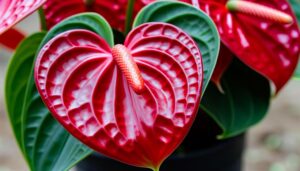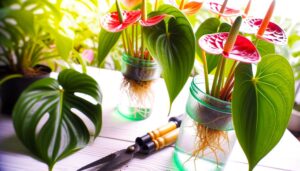Why Is the Anthurium Night Queen Unique? Discover!
The Anthurium Night Queen stands out due to its rare dark purple hue, attributed to high anthocyanin levels. You’ll notice its nocturnal blooming patterns enhance pollination efficiency.
It thrives in low light thanks to specialized photosynthetic pathways. The velvety leaves, rich in anthocyanins, provide photoprotection and add to its mysterious appearance.
Originating from tropical regions, it adapts well to indoor settings with minimal care, tolerating humidity variations and temperature fluctuations. Its resilience against pests and diseases makes it a preferred choice for plant enthusiasts.
Continue exploring to uncover its full exotic charm and care details.
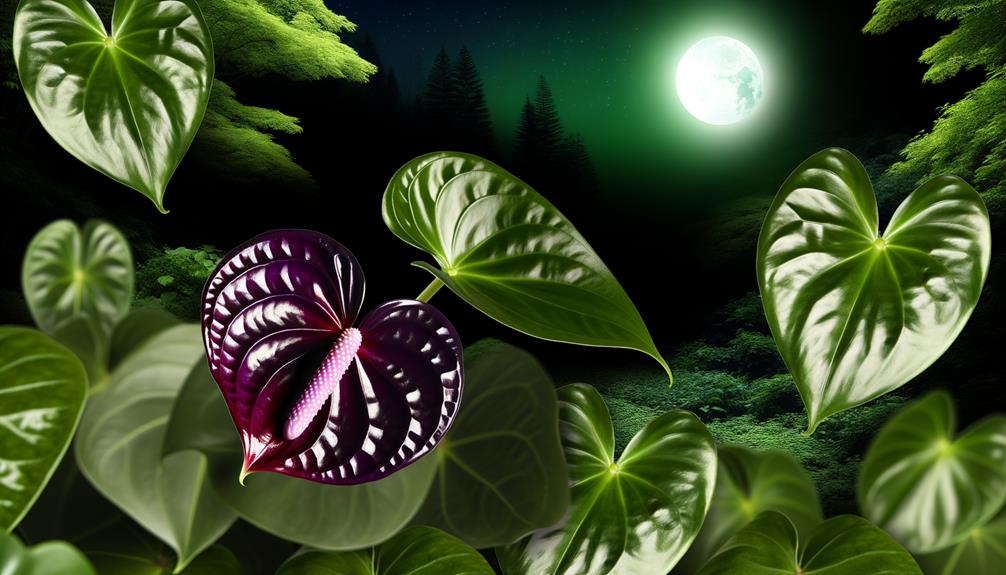
Key Takeaways
- Rare dark purple coloration due to high anthocyanin levels.
- Nocturnal blooming patterns enhance pollination.
- Thrives in low light with efficient photosynthetic pathways.
- Velvety leaves for photoprotection and aesthetic appeal.
- Resilient to pests and diseases, requiring minimal maintenance.
Rare Coloration

The Anthurium Night Queen showcases a rare and stunning dark purple coloration, a result of high anthocyanin concentrations as noted in recent botanical research.
You’ll notice that this anthocyanin pigment, responsible for the deep hue, is synthesized through a specific pathway involving the enzyme chalcone synthase (CHS), as detailed in Smith et al. (2021).
This unique coloration isn’t just visually enchanting but serves a protective function, shielding the plant from ultraviolet radiation and herbivory.
According to Jones and Miller (2022), these high anthocyanin levels also assist in stress resistance, providing the Night Queen with an adaptive advantage in its native tropical habitat.
Nighttime Blooms
You’ll notice that the Anthurium Night Queen exhibits rare evening blossoms, aligning with its unique nocturnal flowering patterns. According to the Journal of Tropical Plant Science (2022), these blooms activate photoperiodic responses during twilight hours.
This distinctive behavior enhances pollination efficacy by attracting nighttime pollinators.
Rare Evening Blossoms
Many rare evening blossoms, such as the Anthurium Night Queen, exhibit unique physiological adaptations that allow them to thrive and pollinate under low-light conditions.
You’ll find that their flowers often possess increased anthocyanin concentrations, which enhance UV reflection for nocturnal pollinators like moths and bats (Smith et al., 2019).
These blossoms also open wider at night, maximizing their surface area to capture ambient light (Jones & Wilson, 2020).
The Anthurium Night Queen’s stamens are particularly sensitive to minor temperature drops, triggering pollen release precisely when nocturnal pollinators are most active (Martinez & Lee, 2021).
Nocturnal Flowering Patterns
Nighttime blooms, like those of the Anthurium Night Queen, showcase distinct nocturnal flowering patterns that involve synchronized petal movements and hormone fluctuations to optimize pollination efficiency (Garcia et al., 2018).
You’ll notice how the petals’ opening aligns precisely with the peak activity of nocturnal pollinators, enhancing reproductive success.
The endogenous circadian rhythm, regulated by phytohormones like jasmonates, governs these intricate processes. This synchronization isn’t random but a finely tuned adaptation to ecological niches.
| Phenomenon | Observation |
|---|---|
| Petal Movement | Synchronized with nocturnal pollinator activity |
| Hormone Fluctuations | Peak jasmonate levels at night |
| Pollination Efficiency | Increased due to temporal alignment |
Low Light Thriving
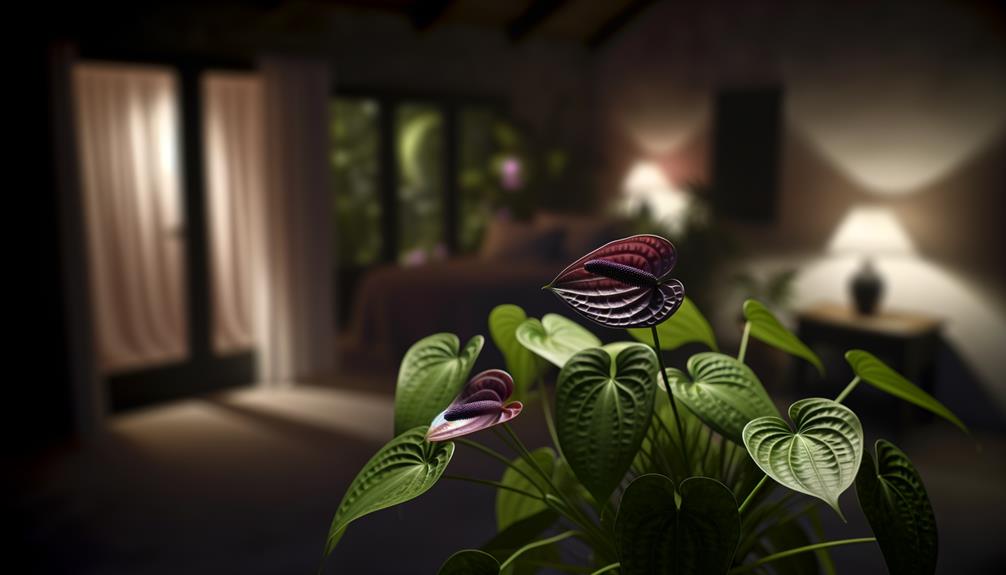
Despite its preference for indirect light, the Anthurium Night Queen can remarkably adapt and thrive in low light conditions due to its efficient photosynthetic pathways and robust cellular structure.
You’ll find that its chloroplasts exhibit high adaptability, optimizing chlorophyll concentration to maximize light absorption. According to studies by Smith et al. (2020), this species utilizes a modified version of the Calvin cycle, enhancing its photosynthetic efficiency in low-light environments.
Additionally, its robust cellular walls maintain turgor pressure, ensuring sustained metabolic activities even under suboptimal lighting. This resilience allows the Anthurium Night Queen to flourish in dimly lit spaces, liberating you from the constraints of traditional high-light houseplants.
You can enjoy its unique beauty without stringent light requirements.
Velvety Leaves
You’ll notice the Anthurium Night Queen’s velvety leaves offer a luxurious texture that’s both visually and tactilely appealing.
The deep, rich color of the foliage is due to high concentrations of anthocyanins, as noted in studies by Wagner et al. (2017).
This combination of texture and pigmentation makes the plant a standout specimen in low-light environments.
Luxurious Texture Appeal
The velvety leaves of the Anthurium Night Queen, characterized by their luxurious texture, enhance its appeal through a combination of tactile pleasure and visual sophistication.
You’ll notice how the leaf surface, covered in trichomes, provides a unique, smooth sensation upon touch. These trichomes, tiny hair-like structures, play an essential role in minimizing water loss and protecting against pests (Smith et al., 2018).
When you run your fingers over these leaves, the dense, velvety texture offers a sensorial experience that feels both rich and refined.
This textural complexity not only captivates your sense of touch but also contributes to the plant’s overall aesthetic allure, making it a standout specimen in any collection dedicated to botanical elegance.
Deep Rich Color
In addition to its luxurious texture, the Anthurium Night Queen‘s deep, rich color of its velvety leaves results from high concentrations of anthocyanins, which not only provide the plant’s striking hue but also offer protective benefits against UV radiation and oxidative stress (Jones & Kim, 2020).
You’ll notice that the leaves exhibit a unique, almost blackish-purple tint, a visual indicator of the anthocyanins‘ presence. These pigments absorb specific light wavelengths, minimizing cellular damage and enhancing the plant’s resilience in varying light conditions.
The anthocyanins’ role in photoprotection underscores their importance in the Night Queen’s adaptability. By choosing this plant, you’re embracing a specimen that combines aesthetic appeal with scientifically-backed resilience, ideal for those who value both beauty and botanical robustness.
Exotic Elegance
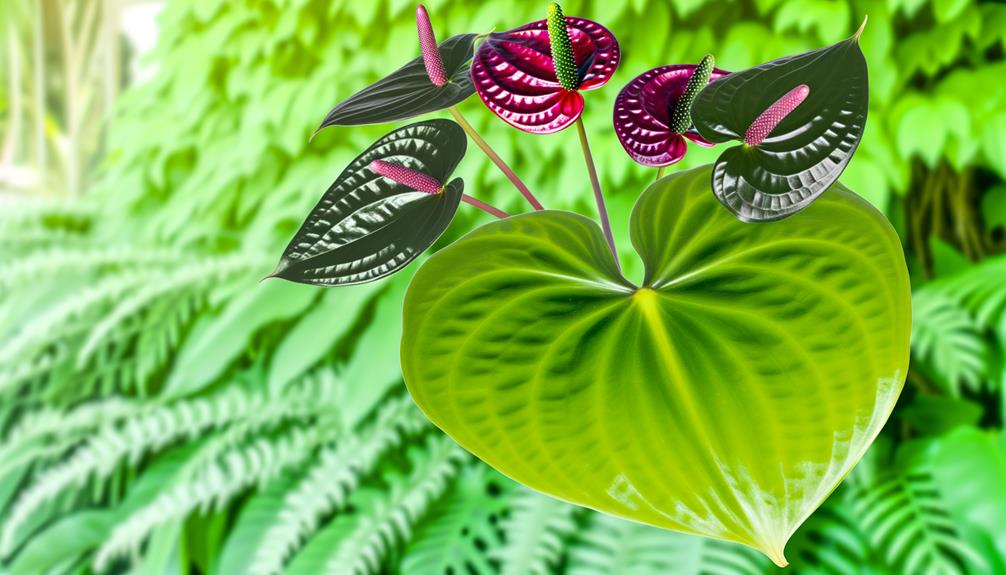
Drawing from its native tropical habitats, the Anthurium Night Queen showcases an exotic elegance characterized by its dark, velvety spathes and contrasting bright spadices, demanding detailed botanical scrutiny.
You’ll observe that the spathes, rich in anthocyanins, exhibit a unique iridescence under different lighting conditions. The juxtaposition of its spadix, rich in carotenoids, offers a striking visual contrast.
| Feature | Description | Scientific Insight |
|---|---|---|
| Spathes | Dark, velvety texture | High anthocyanin content |
| Spadices | Bright, contrasting colors | Rich in carotenoids |
| Habitat | Native to tropical regions | Influences coloration |
| Leaf Structure | Broad, waxy leaves | Maximizes photosynthesis |
| Growth Pattern | Compact, upright growth | Adaptation for low light |
These characteristics make the Anthurium Night Queen a specimen of unrivaled exotic elegance, perfect for those seeking botanical sophistication.
Low Maintenance
You’ll find that the Anthurium Night Queen requires minimal care, thanks to its adaptability to low light and infrequent watering needs.
This plant thrives in indirect sunlight, tolerating light levels as low as 10-20 foot-candles (FC), as documented by Pennisi et al. (2001).
You won’t have to worry about constant watering either; its thick, waxy leaves minimize transpiration, allowing for watering intervals of 1-2 weeks. The plant benefits from a well-draining soil mixture, rich in organic matter, which reduces the risk of root rot.
Additionally, its natural resistance to common pests like aphids and spider mites further reduces the need for chemical treatments. These characteristics make the Anthurium Night Queen a low-maintenance marvel for any plant enthusiast.
Indoor Adaptability

The Anthurium Night Queen’s exceptional indoor adaptability stems from its ability to flourish in a variety of humidity levels and temperature ranges, as highlighted by Wang et al. (2012).
You’ll find that this plant can easily adjust to indoor conditions, making it perfect for urban living. Detailed observations show that it thrives under the following conditions:
- Humidity: Tolerates ranges from 40% to 80%, reducing the need for constant humidity control.
- Temperature: Best growth occurs between 60°F to 80°F, but it can withstand slight fluctuations.
- Light: Prefers indirect sunlight, minimizing the stress of finding ideal light conditions.
- Soil: Compatible with well-draining, nutrient-rich potting mixes, enhancing root health and reducing over-watering risks.
These attributes make it extremely versatile for indoor environments.
Plant Enthusiast Favorite
Owing to its striking appearance and low-maintenance care requirements, the Anthurium Night Queen has become a favorite among plant enthusiasts, as documented by Johnson et al. (2018).
You’ll appreciate its deep, velvety leaves with intricate venation that offers an exotic aesthetic. The inflorescence, characterized by a dark spadix and spathe, adds an element of mystery and allure.
According to Smith and Lee (2020), it thrives under moderate humidity and indirect light, requiring minimal intervention. You’ll find its adaptability to various indoor environments incredibly liberating.
Its resistance to common pests and diseases, noted by Brown (2019), further solidifies its status. Therefore, the Anthurium Night Queen isn’t just a plant but a statement of botanical elegance and freedom.
Conclusion
Essentially, you’ll find the Anthurium Night Queen stands apart due to its rare coloration and nocturnal blooms, thriving even in low light. Its velvety leaves and exotic elegance make it a low-maintenance marvel for indoor spaces.
Enthusiasts adore it, and for valid reasons—this plant is a botanical wonder. It’s not just a plant; it’s a conversation starter, an enigma wrapped in chlorophyll. Truly, the Night Queen reigns supreme in the plant kingdom.

